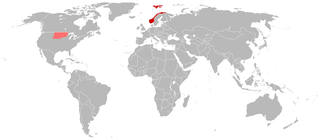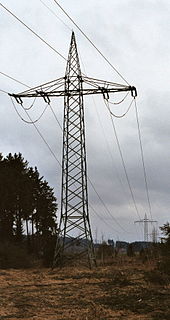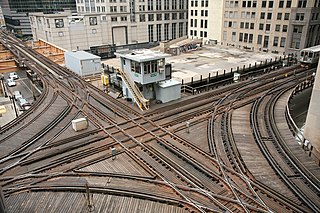
The Eastern Østfold Line is a 79-kilometer (49 mi) railway line which runs between Ski and Sarpsborg. It follows a more eastern route than the Østfold Line, with which it adjoins at both Ski Station and Sarpsborg Station, serving the Indre Østfold district. The line is single track and electrified. The Eastern Line serves the hourly L22 lines of the Oslo Commuter Rail, operated by the Norwegian State Railways. There is no regular traffic south of Rakkestad Station, although the line can be used for freight trains when the Western Line is closed.

The Numedal Line is a 92.8-kilometer (57.7 mi) long railway line that runs up the Numedal valley between Kongsberg and Rødberg in Buskerud, Norway. Built and operated by the Norwegian State Railways, the non-electrified, standard gauge line passes through the municipalities of Kongsberg, Flesberg, Rollag and Nore og Uvdal. It is now owned by the Norwegian National Rail Administration.

Lieråsen Tunnel is a single-tubed railway tunnel of the Drammen Line situated in Asker, Røyken and Lier in Norway. At a length of 10.723 kilometers (6.663 mi), the double track tunnel is located immediately between Asker Station and Lier Station. It is used for a mix of short- and long-haul passenger trains and freight trains.
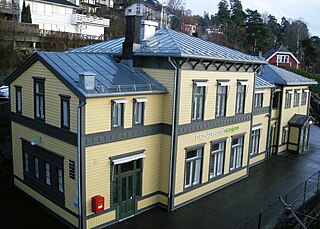
Nordstrand Station is a railway station on the Østfold Line. It is located in the Nordstrand borough of Oslo, Norway. Situated 5.95 kilometers (3.70 mi) from Oslo Central Station, it features an island platform. Nordstrand is served by the Line L2 of the Norwegian State Railways's Oslo Commuter Rail, providing two services each hour.

Oslo Commuter Rail is a commuter rail centered in Oslo, Norway, connecting the capital to six counties in Eastern Norway. The system is operated by the Norwegian State Railways (NSB) and its subsidiary NSB Gjøvikbanen, using Class 69 and Class 72 electric multiple units (EMU). The network spans eight routes and 128 stations, with Oslo Central Station (Oslo S) as the central hub. The trains run on 553 kilometers (344 mi) of electrified mainline railway owned by the Norwegian National Rail Administration. Deficits are financed by the Norwegian Ministry of Transport and Communications, although the network also has a ticketing cooperation with Ruter, the public transport authority in Oslo and Akershus. The network is the longest commuter rail network in the Nordic countries, and among top ten in Europe.

Hvalstad Station is a railway station of the Drammen Line located at Hvalstad in Asker, Norway. Situated 20.19 kilometers (12.55 mi) from Oslo Central Station, it consists of an island platform and serves the L1 line of the Oslo Commuter Rail operated by the Norwegian State Railways. The station served 233,000 passengers in 2012.

Ljan Station is a railway station on the Østfold Line. It is located in the Ljan neighborhood in the Nordstrand borough of Oslo, Norway. Situated 7.15 kilometers (4.44 mi) from Oslo Central Station, it features two side platforms. Hauketo is served by the Line L2 of the Norwegian State Railways's Oslo Commuter Rail, providing two services each hour.

Hauketo Station is a railway station on the Østfold Line. It is located in the Hauketo neighborhood in the Søndre Nordstrand borough of Oslo, Norway. Situated 8.68 kilometers (5.39 mi) from Oslo Central Station, it features two side platforms. Hauketo is served by the Line L2of the Norwegian State Railways's Oslo Commuter Rail, providing two to four services each hour.

Rosenholm Station is a railway station on the Østfold Line located in the Holmlia neighborhood in the Søndre Nordstrand borough of Oslo, Norway. Situated 11.35 kilometers (7.05 mi) from Oslo Central Station, it features two side platforms. Rosenholm is served by the L2 line of the Norwegian State Railways's Oslo Commuter Rail. It features a major park and ride parking lot, but does not have a significant population near by.

Askim Næringspark Station, until 2008 named Næringsparken, was a railway station situated in the eastern outskirts of Askim, Norway. Situated 31.02 kilometers (19.27 mi), it consisted of a single side platform and served an hourly train of the Norwegian State Railways's Oslo Commuter Rail. The station opened on 29 May 1994. It was closed on 9 December 2012 due to low usage, with only 44 average daily boarding and disembarking passengers.
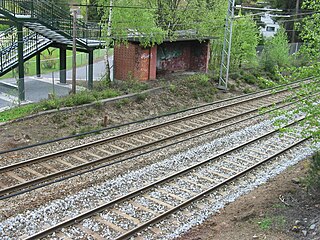
Strand Station was a railway station situated at Strand in Bærum, Norway, on the Drammen Line. The station, located 8.78 kilometers (5.46 mi) from Oslo West Station, was served by Oslo Commuter Rail trains of the Norwegian State Railways. Ramstad opened on 1 November 1931 with two simple side platforms. Ticket sales remained until 1964. The station was one of several closed on 3 July 1973 as part of a service upgrade to speed up local trains on the Drammen Line.

Ramstad Station was a railway station situated at Ramstad in Bærum, Norway, on the Drammen Line. The station, located 10.40 kilometers (6.46 mi) from Oslo West Station, was served by Oslo Commuter Rail trains of the Norwegian State Railways. Ramstad opened on 1 November 1931 with two simple side platforms. Ticket sales remained until 1964. The station was one of several closed on 3 July 1973 as part of a service upgrade to speed up local trains on the Drammen Line.
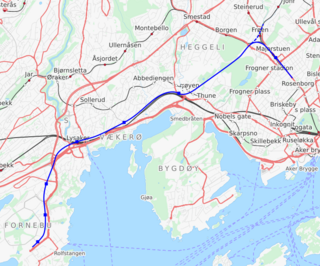
The Fornebu Line is a proposed rail line which would serve the peninsula of Fornebu in Bærum, Norway. The line is in the planning stages and the transit agency Ruter is working towards connecting it to the Oslo Metro. The line has at various stages been proposed as a automated people mover, tram-train, tramway, light rail, stadtbahn, rapid transit, bus rapid transit and commuter rail. The current proposal consists of a metro line starting at Majorstuen Station and running entirely in a tunnel for 8,150 meters (26,740 ft). It would possible have a station at Madserud, and then stations at Skøyen, Vækerø, Lysaker, Telenor Arena, Flytårnet and Fornebu Senter. A depot would be built at Fornebu and the line would connect to the metro's Common Tunnel at Majorstuen.

Bekkelaget Station was a railway station on the Østfold Line. It was located at Nedre Bekkelaget in the Nordstrand borough of Oslo, Norway. It was originally situated 3.34 kilometers (2.08 mi) from Oslo Central Station and received a station building designed by Peter Andreas Blix. It was named Bækkelaget until 1921.

The Hølen Viaduct is a disused iron railway viaduct situated at Hølen in Akershus, Norway. The iron carried a single track of the Østfold Line over the river Såna and the valley where the village of Hølen is located. The viaduct was the first pendulum pillar bridge in the world, and was designed by the principle's inventor, Axel Jacob Petersson. It is 130.6 meters (428 ft) long.

The Hølendalen Bridges are three parallel concrete cantilever bridge which cross Hølendalen in Vestby, Norway. One carries two tracks of the Østfold Line, the other two carry four lanes of European Road E6. The bridges have four spans, the two in center at 128 meters (420 ft) and the two outer at 80 meters (260 ft). The overall lengths are 416 meters (1,365 ft). The bridges are up to 50 meters (160 ft) above the valley and the creek of Såna.

Berg Station is a closed railway station on the Østfold Line located at Berg in Halden, Norway. It is situated 130.96 kilometers (81.37 mi) from Oslo Central Station. Although disused as a passenger station, Berg still serves as a passing loop and a freight terminal, the Halden Terminal.

Sarp Bridge is a series of bridges which span across Sarpefossen, a waterfall of the river Glomma in Sarpsborg, Norway. In the current arrangement, one bridge carries a pathway, one carries a single track of the Østfold Line and one carries two lanes of National Road 118. The road and pathway bridges are about 91 meters (299 ft) long, while the railway bridge is 247 meters (810 ft).
